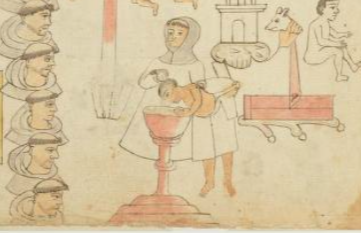necuaatequiliztli (Azca31)
This unglossed painting features a baptism scene, which we are labeling as a necuaatequiliztli, which was a common term, a loanword for the act of baptism, commonly found in Nahuatl alphabetic records. This is not a hieroglyph but a scene shared here as an example of the iconography of colonial religious elements in codices. The presiding priest appears in a frontal view wearing a white robe with a gray hood. He helps wet the head of a person at a baptismal font. This person has taken his shirt off, leaving it around his waist. He also wears loose trousers. The font is largely red, but left white on the right side, suggesting a three-dimensionality.
Stephanie Wood
For the purpose of comparison, see the baptismal font from the Codex Sierra-Texupan, below. The hood worn by the priest may be the same hood that is shown pulled off the heads of the priests in the example of padresme (Azca31).
Stephanie Wood
post-1550, possibly from the early seventeenth century.
Jeff Haskett-Wood
bautismos
necuaatequiliz(tli), baptism, https://nahuatl.wired-humanities.org/content/necuaatequiliztli
el bautismo
Stephanie Wood
The Codex Azcatitlan is also known as the Histoire mexicaine, [Manuscrit] Mexicain 59–64. It is housed in the Bibliothèque Nationale de France, and hosted on line by the World Digital Library and the Library of Congress, which is “unaware of any copyright or other restrictions in the World Digital Library Collection.”
https://www.loc.gov/resource/gdcwdl.wdl_15280/?sp=31&st=image
The Library of Congress is “unaware of any copyright or other restrictions in the World Digital Library Collection.” But please cite Bibliothèque Nationale de France and this Visual Lexicon of Aztec Hieroglyphs.


